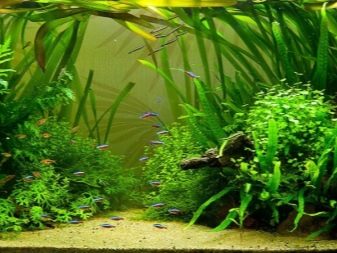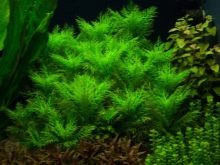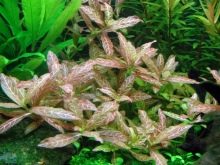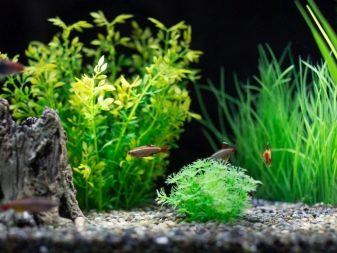Many aquarium fish lovers try to create their pets the most comfortable conditions, close to those that are characteristic of the natural habitat of fish. For this, natural underwater plants are used in the tank instead of artificial analogues. However, not everyone knows how to properly grow such flora, which species are best suited for specific fish and how to properly care for the vegetation in the aquarium.
All of these details will be described in detail in this article.

Functions
The living vegetation in the fish house has a number of very useful properties that cannot be replaced using artificial decor.
- Oxygen production. By promoting photosynthesis processes in the aquarium by using fluorescent lamps, you will saturate the aquarium with pure oxygen rather than the gas mixture created by the compressor. Also, representatives of the flora will help absorb carbon dioxide molecules formed during the breathing of fish. This compressor also does not.
Underwater plants themselves will also emit carbon dioxide in the course of their life, but its percentage will be compensated by the amount of substance absorbed during the day. At night, it is still recommended to purge using a compressor.

- Maintaining the nitrogen cycle. For its implementation, it is necessary to plant a rapidly growing flora in the aquarium, which will reduce the concentration of ammonia during the launch and at the initial stage of keeping fish.Ammonium levels increase due to increased excrement and can be fatal for some species. Plants with long stems are able to absorb part of this substance, minimizing harm to the inhabitants of the aquarium.
If acidity increases in water, another deadly compound is formed - ammonia. Already at pH above 7, ammonia can harm pets. Therefore, plants are needed that, feeling comfortable in an acidic environment, absorb excess substances.
When the nitrogen cycle is established in the aquarium during the process of absorption of oxygen and the aforementioned compounds, the frequency of water change will change. The main goal of this procedure - reducing nitrate levels - will be achieved at the expense of plants, and water change can be carried out not so often.

- Fight against algae. Algae, which over time can form on filtration systems and on the walls of the tank, violate both the aesthetics and functionality of the aquarium. It is aquatic vegetation of a higher class, absorbing the substances necessary for the nutrition of algae, over time relieves them of the capacity with fish.

- Power source for aquarium inhabitants. For a variety of nutrition and activation of fish development processes in their diet, the leaves of aquarium plants will not be superfluous. Eating them in small quantities, the inhabitants of the tank strengthen the body. However, if the fish are herbivorous, make sure that they do not eat too much vegetation from the tank. This can be achieved by replacing the grass with suitable feed.

- Decorative function. The advantage of living aquarium representatives of the flora is the change in their appearance in the process of growth and development. Plants can branch, form whole bushes, pleasantly pleasing to the eye. The growth process itself is also very exciting to watch.

Kinds
Living plants for a home aquarium are divided into different types:
- fast-growing flora with elongated stems;
- slow-growing, which sometimes have long stems, but in most cases, ground cover or bushy;
- floating - they do not take root in the aquarium and simply swim in the water column;
- mossy - cover the bottom, forming a layer resembling moss (as their name implies);
- requiring landings;
- covering the water surface.
Which is better to choose for an aquarium?
Among the entire list of plants for a home tank with fish, it can be difficult, especially for beginners, to choose suitable varieties. You can pay attention to the options presented below.
- White-headed hydrocolyte will be a great solution for those who are just trying their hand in the aquarium industry. This plant, which is easy to maintain, is resistant to changes in the microclimate and conditions in the tank.
Its greenery spreads over the surface of the water and grows more intensively with increased light. Such flora blooms in small white flowers. Of the additional procedures, the plant needs regular pruning.


- Hygrophils have similar characteristics. The only difference is that they grow in the ground and have fairly powerful roots. They can form whole thickets, becoming a convenient refuge for small fish. If the plants are heavily lit over time, their surface may turn red.



- To create a green coating on the soil of the aquarium, Marsilia is suitable. Her small, shiny leaves, forming 4 faces in the mix, make her look like clover. This plant is especially suitable for an aquarium with fry, as it will serve them as an excellent shelter.


- The Thai fern is able to survive in almost any environment. Its long leaves can be the same or have a different shape, as in some varieties. It can even be placed in those aquariums where fish live on natural greens.


How to grow from seeds at home?
It is possible to grow aquarium plants on their own, not only in a vegetative way, but also from seeds. To do this, you must follow a certain algorithm of actions.
- Treat the seeds with special preparations that stimulate the root formation process. Prepare a heteroauxin solution by taking one tablet (100 mg) in 2 liters of water.
- Place the seeds in this solution and leave for 7 hours.
- Next, place the seeds in a small jar of drinking water and, having covered with a lid, place in a warm place. Remember that the temperature in the jar should not exceed 25 degrees, otherwise the process of decay may begin.
- In another container, prepare the soil for future plants. It is based on components such as river sand, vermiculite, fine gravel, as well as peat chips.
- As soon as the seeds germinate in the first container, they must be moved to the one where the soil is. It is better to put them not very close to each other, so that there is room for growth.
- If the seeds are large, then you can place them deeper into the ground than small ones.
- Further, the cultivation of seeds is carried out by maintaining a high level of humidity and protection against algae.



Care
Sprouting aquarium flora is not enough.
It is also important to take special care of her, allowing her to benefit the fish and delight the eye of the owner of the aquarium.
Highlight certain nuances and rules of care.
- It is important that the vegetation does not block the bottom of the tank from light. To do this, take care of its location. The best option is a checkerboard pattern.
- Tropical plants are very dependent on lighting. The light phase of some species reaches 12 hours, and it must be maintained using special lamps, the amount of which is measured by the size of the aquarium. An useful element will be a time relay, thanks to which you can extend the period of the light phase to the necessary. Lighting in the tank is created using devices such as incandescent lamps, fluorescent lamps, metal halide or energy-saving lamps, sources with an ultraviolet spectrum.
- If plant propagation is planned, then inexperienced aquarists should start it with the simplest methods, for example, with cuttings.
- That vegetation that has a root system periodically needs additional nutrients. They are introduced using top dressing. The dosage of tablets does not exceed 1-2 for each plant, but be sure to calculate the amount in accordance with the instructions.
- Take care of the location of the aquarium flora that prefers shade, especially if it is planned to combine such plants with photophilous in one tank. Shady species are better placed so that they are covered by the crowns of neighboring plants, and plentiful rays of light do not fall on them.
- Even if algae begin to form in the aquarium with young plants, this does not mean that they should be removed or water should be constantly changed. It is better to give higher plants time to adapt. Subject to all conditions, they will soon become stronger in the tank, begin to develop, and the algae themselves are gradually minimized.


Disease
It is worth remembering: like any living organisms, aquarium vegetation can undergo some ailments. Each of them has a special reason that needs to be fixed:
- plant growth slows with a lack of carbon;
- phosphorus deficiency is leaf falling;
- if the leaves are significantly smaller than they should be, then the proportions between light and temperature in the tank are broken;
- when the soil is too tightly compacted and the substrate needs to be replaced, the roots may turn black.
- the leaves are pale in color, as well as the fineness of the stems due to lack of lighting;
- when the greens turn red or yellow, this indicates an insufficient amount of nitrogen in the water.



About the most unpretentious aquarium plants, see below.










